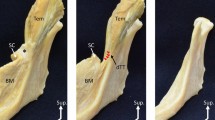Abstract
The stylopharyngeus plays a critical role in the clearance of the piriform recess. We dissected 78 sides of the pharynx from 55 donated cadavers and observed histology of another seven sides of the pharynx from seven cadavers. The stylopharyngeus consistently comprised (1) a descending muscle bundle surrounding the piriform recess and (2) an additional short sheet inserting into the tonsillar bed. Histologically, the former bundle connected to a thick fascia providing the lateral glossoepiglottic fold, extending along the submucosa of the piriform recess, and covering the thyroid cartilage, whereas the latter sheet intermingled with other pharyngeal wall muscles at and near the tonsillar bed. Notably, in 44.4% of female specimens, the additional sheet occupied a greater proportion in cross section than the descending muscle bundle. Given the different directions, the additional sheet seemed to check clearance function of the descending bundle for the piriform recess. Thus, particularly in women, interindividual differences in pharyngeal clearance were likely to depend on whether the additional sheet is strong or weak. Chin down in combination with tilting and rotating the head may represent effective exercises of the stylopharyngeus that could compensate for the disadvantages of additional insertion.





Similar content being viewed by others
References
Dejaeger E, Pelemans W, Ponette E, Joosten E. Mechanisms involved in postdeglutition retention in the elderly. Dysphagia 1997;12:63–67.
Olson R, Castell J, Johnston B, Ekberg O, Castell DO. Combined videomanometric identification of abnormalities related to pharyngeal retention. Acad Radiol 1997;4:349–354.
Smith CH, Logemann JA, Colangelo LA, Rademaker AW, Pauloski BR. Incidence and patient characteristics associated with silent aspiration in the acute care setting. Dysphagia 1999;14:1–7.
Eisenhuber E, Schima W, Schober E, Pokieser P, Stadler A, Scharitzer M, Oschatz E. Videofluoroscopic assessment of patients with dysphagia: pharyngeal retention is a predictive factor for aspiration. AJR Am J Roentgenol 2002;178:393–398.
Kahrilas PJ, Logemann JA. Pharyngeal structure and function. Dysphagia 1993;8:303–307.
Bannister L, Respiratory System. In: Williams PL, Editor. Gray’s Anatomy, 39th ed. London: Churchill & Livingstone, 1995, pp 1627–1682.
Netter FH. Atlas of Human Anatomy, 4th ed. Oxford: Saunders, 2006, p 63.
Seta H, Inada H, Abo M, Sugimoto A, Miyano S. Upper esophageal imaging patterns by videofluoroscopic examination in the anterior-posterior planes: laterality of pharyngoesophageal segment flow. Jpn J Rehabil Med 2004;5:307–312.
Ohkuma R, Fujishima I, Takehara I, Ishii M, Miyono S. Transmucosal surface electromyography of cricopharyngeal muscle using a catheter electrode. Jpn J Rehabil Med 1999;6:410–414.
Masuda Y. Clinical and immunological study of IgA nephropathy before and after tonsillectomy. Acta Otolaryngol (Stockh) Suppl 1988;45:248–255.
Shimada L, Gasser RF. Variations of the pharyngeal raphe. Clin Anat 1988;1:285–294.
Todd TW, Fowler RH. The muscular relationships of the tonsil. Am J Anat 1927;40:355–371.
Moore KL. Clinical Oriented Anatomy, 2nd ed. Baltimore: Williams & Wilkins, 1980, pp 1036–1047.
Hollinshead WH. Anatomy for Surgeons, vol 1, 3rd ed. Philadelphia: Harper & Row, 1982, pp 394–400.
Beasley P. Anatomy of the pharynx and oesophagus. In: Wright D, Editor. Scott-Brown’s Otolaryngology, vol 1, 5th ed. London: Butterworths, 1987, pp 252–271.
Ohtsuka K, Tomita H, Murakami G. Anatomy of the tonsillar bed: topographical relationship between the palatine tonsil and the lingual branch of the glossopharyngeal nerve. Acta Otolaryngol Suppl 2002;546:99–109.
Ekberg O. Posture of the head and pharyngeal swallowing. Acta Radiol Diagn (Stockh) 1986;6:691–696.
Logemann JA, Kahrilas PJ, Kobara M, Vakil NB. The benefit of head rotation on pharyngoesophageal dysphagia. Arch Phys Med Rehabil 1989;70:767–771.
Logemann JA. The role of exercise programs for dysphagia patients. Dysphagia 2005;20:139–140.
Welch MV, Logemann JA, Rademaker AW, Kahrilas PJ. Changes in pharyngeal dimensions effected by chin tuck. Arch Phys Med Rehabil 1993;74:178–181.
Shanahan TK, Logemann JA, Rademaker AW, Pauloski BR, Kahrilas PJ. Chin-down posture effect on aspiration in dysphagic patients. Arch Phys Med Rehabil 1993;74:736–739.
Shaker R, Kern M, Bardan E, Taylor A, Stewart ET, Hoffmann RG. Augmentation of deglutitive upper esophageal sphincter opening in the elderly by exercise. Am J Physiol 1997;272:G1518–G1522.
Ertekin C, Keskin A, Kiylioglu N, Kirazli Y, On AY, Tarlaci S, Aydogdu I. The effect of head and neck positions on oropharyngeal swallowing: A clinical and electrophysiologic study. Arch Phys Med Rehabil 2001;82:1255–1260.
Lewin JS, Hebert TM, Putnam JB Jr, DuBrow RA. Experience with the chin tuck maneuver in postesophagectomy aspirators. Dysphagia 2001;16:216–219.
Büllow M, Olsson R, Ekberg O. Videomanometric analysis of supraglottic swallow, effortful swallow, and chin tuck in patients with pharyngeal dysfunction. Dysphagia 2001;16:190–195.
Easterling C, Grande B, Kern M, Sears K, Shaker R. Attaining and maintaining isometric and isokinetic goals of the Shaker exercise. Dysphagia 2005;20:133–138.
Acknowledgments
The authors are grateful to Professor Toshihiko Yajima, Department of Oral Anatomy, Health Science University of Hokkaido; Professor Shigemitsu Yoshida, Department of Oral Anatomy, Hokkaido University School of Dentistry; and Professor Shigetaka Yoshida, Department of Anatomy, Asahikawa Medical University School of Medicine, for their permission to use their materials.
Author information
Authors and Affiliations
Corresponding author
Additional information
This work was performed at the Department of Anatomy, Sapporo Medical University, School of Medicine, Sapporo, Japan.
Rights and permissions
About this article
Cite this article
Meng, H., Murakami, G., Suzuki, D. et al. Anatomical Variations in Stylopharyngeus Muscle Insertions Suggest Interindividual and Left/Right Differences in Pharyngeal Clearance Function of Elderly Patients: A Cadaveric Study. Dysphagia 23, 251–257 (2008). https://doi.org/10.1007/s00455-007-9131-2
Received:
Accepted:
Published:
Issue Date:
DOI: https://doi.org/10.1007/s00455-007-9131-2




